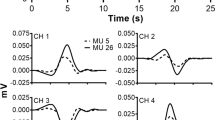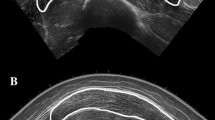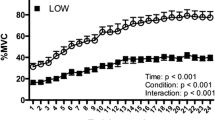Abstract
The present study was undertaken to investigate in a randomized controlled trial the effects of chronic (10 weeks, 4 h per day, 7 days per week) low-frequency (15 Hz) stimulation (CLFS) of the knee extensor and hamstring muscles of both legs in healthy volunteers via surface electrodes. A control group (n=10) underwent the same treatment (sham stimulation) as the CLFS-treated group (n=10), except that stimulation intensity was kept at a level which did not evoke contractions. Biopsy samples were taken before the onset and after cessation of stimulation from the right vastus lateralis muscle of all subjects. The biopsy samples were analyzed for changes in myosin heavy chain (MHC) isoforms and activities of citrate synthase (CS) and glyceraldehyde phosphate dehydrogenase (GAPDH) as markers of aerobic-oxidative and anaerobic pathways of energy metabolism, respectively. In addition, functional properties, i.e., oxygen consumption (V̇O2) and work capacity, were assessed. Sham stimulation did not affect the functional properties and had no detectable effect on MHC isoform and enzyme activity patterns. Conversely, CLFS induced changes in the MHC isoform pattern in the fast-to-slow direction with a ~20% decrease in the relative concentration of MHCIId/x (from 28% to 22%) and a ~10% increase in the relative concentration of MHCI (from 30% to 34%). In addition, CLFS led to a ~9% increase in the activity of CS concomitant with a ~7% decrease in the activity of GAPDH. This increase in aerobic-oxidative capacity was accompanied by improved work capacity and V̇O2 at the anaerobic threshold by 26% and 20%, respectively.





Similar content being viewed by others
References
Andersen JL, Mohr T, Biering-Sörensen F, Galbo H, Kjaer M (1996) Myosin heavy chain isoform transformation in single fibres from m. vastus lateralis in spinal cord injured individuals: effects of long-term functional electrical stimulation (FES). Pflugers Arch 431:513–518
Bass A, Brdiczka D, Eyer P, Hofer S, Pette D (1969) Metabolic differentiation of distinct muscle types at the level of enzymatic organization. Eur J Biochem 10:198–206
Brown WE, Salmons S, Whalen RG (1983) The sequential replacement of myosin subunit isoforms during muscle type transformation induced by long term electrical stimulation. J Biol Chem 258:14686–14692
Conjard A, Peuker H, Pette D (1998) Energy state and myosin isoforms in single fibers of normal and transforming rabbit muscles. Pflugers Arch 436:962–969
Edwards RHY, Jones DA, Newham DJ (1982) Low-frequency stimulation and changes in human muscle contractile properties. J Physiol (Lond) 328:29P–30P
Ennion S, S'Antana Pereira J, Sargeant AJ, Young A, Goldspink G (1995) Characterization of human skeletal muscle fibres according to the myosin heavy chains they express. J Muscle Res Cell Motil 16:35–43
Gauthier JM, Thériault R, Thériault G, Gélinas Y, Simoneau JA (1992) Electrical stimulation-induced changes in skeletal muscle enzymes of men and women. Med Sci Sports Exerc 24:1252–1256
Hämäläinen N, Pette D (1996) Slow-to-fast transitions in myosin expression of rat soleus muscle by phasic high-frequency stimulation. FEBS Lett 399:220–222
Harridge SDR, Andersen JL, Hartkopp A, Zhou S, Biering-Sorensen F, Sandri C, Kjaer M (2002) Training by low-frequency stimulation of tibialis anterior in spinal cord-injured men. Muscle Nerve 25:685–694
Henriksson KG (1979) Semi-open muscle biopsy technique. Acta Neurol Scand 59:317–323
Hoppeler H (1990) The range of mitochondrial adaptation in muscle fibers. In: Pette D (ed) The dynamic state of muscle fibers. de Gruyter, Berlin, pp 567–586
Mabuchi K, Sréter FA (1980) Actomyosin ATPase. II Fiber typing by histochemical ATPase reaction. Muscle Nerve 3:233–239
Maier A, Gambke B, Pette D (1986) Degeneration-regeneration as a mechanism contributing to the fast to slow conversion of chronically stimulated fast-twitch rabbit muscle. Cell Tissue Res 244:635–643
Martin TP, Stein RB, Hoeppener PH, Reid DC (1992) Influence of electrical stimulation on the morphological and metabolic properties of paralyzed muscle. J Appl Physiol 72:1401–1406
Oakley BR, Kirsch DR, Morris NR (1980) A simplified ultrasensitive silver stain for detecting proteins in polyacrylamide gels. Anal Biochem 105:361–363
Pérez M, Lucia A, Rivero JLL, Serrano AL, Calbet JAL, Delgado MA, Chicharro JL (2002) Effects of transcutaneous short-term electrical stimulation on M. vastus lateralis characteristics of healthy young men. Pflugers Arch 443:866–874
Pette D, Reichmann H (1982) A method for quantitative extraction of enzymes and metabolites from tissue samples in the milligram range. J Histochem Cytochem 30:401–402
Pette D, Staron RS (1990) Cellular and molecular diversities of mammalian skeletal muscle fibers. Rev Physiol Biochem Pharmacol 116:1–76
Pette D, Staron RS (1997) Mammalian skeletal muscle fiber type transitions. Int Rev Cytol 170:143–223
Pette D, Staron RS (2001) Transitions of muscle fiber phenotypic profiles. Histochem Cell Biol 115:359–372
Pette D, Vrbová G (1992) Adaptation of mammalian skeletal muscle fibers to chronic electrical stimulation. Rev Physiol Biochem Pharmacol 120:116–202
Pette D, Vrbová G (1999) Invited review: What does chronic electrical stimulation teach us about muscle plasticity? Muscle Nerve 22:666–677
Pette D, Ramirez BU, Müller W, Simon R, Exner GU, Hildebrand R (1975) Influence of intermittent long-term stimulation on contractile, histochemical and metabolic properties of fibre populations in fast and slow rabbit muscles. Pflugers Arch 361:1–7
Peuker H, Conjard A, Pette D (1998) α-Cardiac-like myosin heavy chain as an intermediate between MHCIIa and MHCIβ in transforming rabbit muscle. Am J Physiol 274:C595–C602
Peuker H, Conjard A, Putman CT, Pette D (1999) Transient expression of myosin heavy chain MHCIα in rabbit muscle during fast-to-slow transition. J Muscle Res Cell Motil 20:147–154
Reichmann H, Srihari T, Pette D (1983) Ipsi- and contralateral fibre transformations by cross- reinnervation. A principle of symmetry. Pflugers Arch 397:202–208
Reichmann H, Hoppeler H, Mathieu-Costello O, von Bergen F, Pette D (1985) Biochemical and ultrastructural changes of skeletal muscle mitochondria after chronic electrical stimulation in rabbits. Pflugers Arch 404:1–9
Rutherford OM, Jones DA (1988) Contractile properties and fatiguability of the human adductor pollicis muscle and first interosseus: a comparison of the effects of two chronic stimulation patterns. J Neurol Sci 85:319–331
Salmons S, Henriksson J (1981) The adaptive response of skeletal muscle to increased use. Muscle Nerve 4:94–105
Schantz P, Billeter R, Henriksson J, Jansson E (1982) Training-induced increase in myofibrillar ATPase intermediate fibres in human skeletal muscle. Muscle Nerve 5:628–636
Schiaffino S, Reggiani C (1996) Molecular diversity of myofibrillar proteins: Gene regulation and functional significance. Physiol Rev 76:371–423
Schwerzmann K, Hoppeler H, Kayar SR, Weibel ER (1989) Oxidative capacity of muscle mitochondria: Correlations of physiological, biochemical, and morphometric characteristics. Proc Natl Acad Sci USA 86:1583–1587
Scott OM, Vrbová G, Hyde SA, Dubowitz V (1986) Responses of muscles of patients with Duchenne muscular dystrophy to chronic electrical stimulation. J Neurol Neurosurg Psychiatr 49:1427–1434
Simoneau J-A, Pette D (1988) Species-specific effects of chronic nerve stimulation upon tibialis anterior muscle in mouse, rat, guinea pig, and rabbit. Pflugers Arch 412:86–92
Simoneau J-A, Pette D (1989) Species-specific responses of muscle lactate dehydrogenase isozymes to increased contractile activity. Pflugers Arch 413:679–681
Smerdu V, Karsch-Mizrachi I, Campione M, Leinwand L, Schiaffino S (1994) Type IIx myosin heavy chain transcripts are expressed in type IIb fibers of human skeletal muscle. Am J Physiol 267:C1723–C1728
Staron RS, Hikida RS (1992) Histochemical, biochemical, and ultrastructural analyses of single human muscle fibers, with special reference to the C-fiber population. J Histochem Cytochem 40:563–568
Staron RS, Gohlsch B, Pette D (1987) Myosin polymorphism in single fibers of chronically stimulated rabbit fast-twitch muscle. Pflugers Arch 408:444–450
Sutherland H, Jarvis JC, Kwende MMN, Gilroy SJ, Salmons S (1998) The dose-related response of rabbit fast muscle to long-term low-frequency stimulation. Muscle Nerve 21:1632–1646
Thériault R, Thériault G, Simoneau JA (1994) Human skeletal muscle adaptation in response to chronic low- frequency electrical stimulation. J Appl Physiol 77:1885–1889
Thériault R, Boulay MR, Thériault G, Simoneau JA (1996) Electrical stimulation-induced changes in performance and fiber type proportion of human knee extensor muscles. Eur J Appl Physiol 74:311–317
Wasserman K, Hansen JE, Sue DY, Whipp BJ, Casaburi R (1994) Measurements during integrative cardiopulmonary exercise testing. In: Principles of exercise testing and interpretation. Lea and Febinger, Philadelphia, Pa., pp 52–94
Weiss A, Leinwand LA (1996) The mammalian myosin heavy chain gene family. Annu Rev Cell Dev Biol 12:417–439
Acknowledgements
This study was supported by a grant from the Mayor of the City of Vienna (Forschungsförderungspreis der Stadt Wien) and by a grant from the Deutsche Forschungsgemeinschaft. The authors are grateful to the MEDEL Company (Innsbruck, Austria) for kindly supplying the stimulators.
Author information
Authors and Affiliations
Corresponding author
Rights and permissions
About this article
Cite this article
Nuhr, M., Crevenna, R., Gohlsch, B. et al. Functional and biochemical properties of chronically stimulated human skeletal muscle. Eur J Appl Physiol 89, 202–208 (2003). https://doi.org/10.1007/s00421-003-0792-8
Accepted:
Published:
Issue Date:
DOI: https://doi.org/10.1007/s00421-003-0792-8




